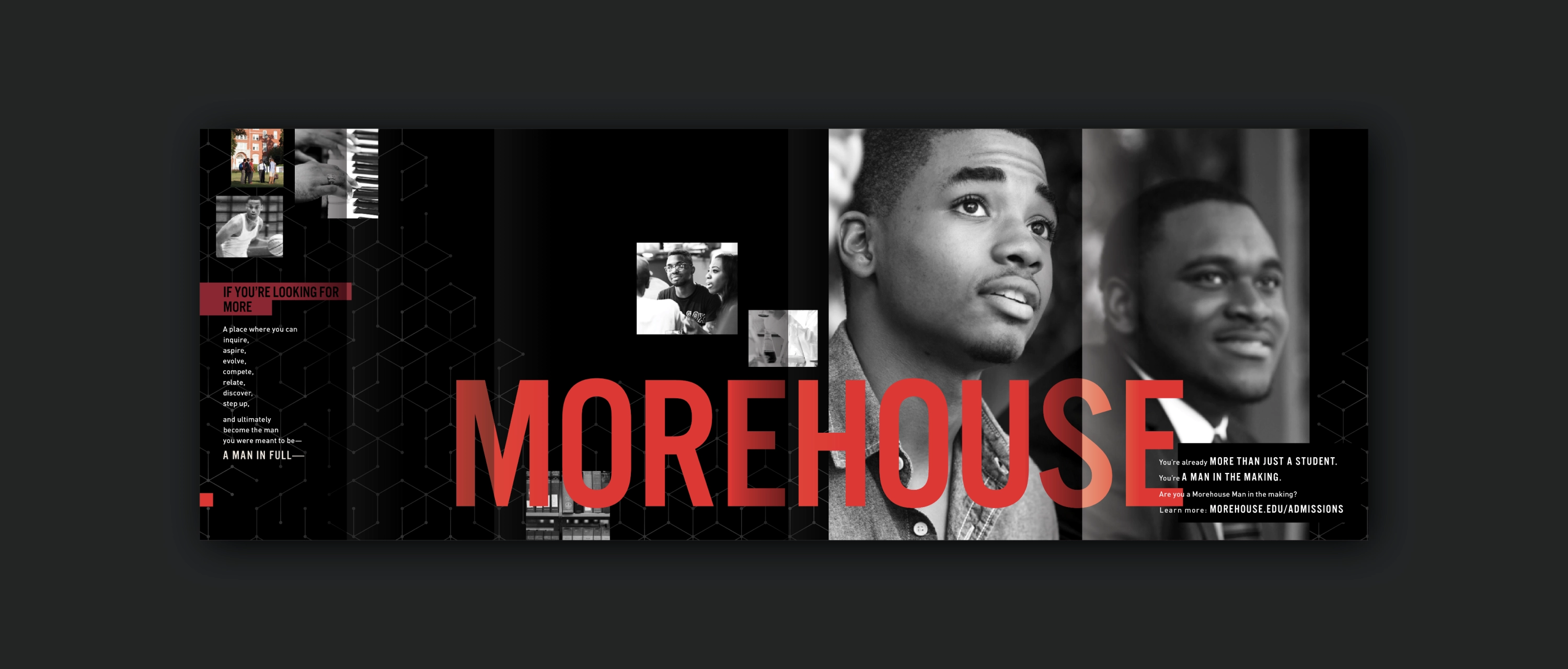Morehouse College
Brand Identity, Digital & Print Design, Campaigns
Rebrand for the legendary HBCU giving revitalized expression to a timeless civil rights legacy.
Morehouse College — renowned, historically Black, male college in Atlanta — has produced some of history’s great Black leaders, most notably the Rev. Martin Luther King, Jr. But over the past half-century predominantly white colleges and universities had been chipping away at its enrollment, heavily recruiting Black students as they integrated, offering financial incentives and better resources, especially to the highest performing prospects. This led to eroding enrollment at Historically Black Colleges and Universities (HBCUs) and a perception, even in the Black community, that they were a second-rate option.
Underfunded and struggling to attract top students, Morehouse continued doing that for which it had long been widely recognized: “punching above its weight.” And not solely in educating civil rights pioneers but in cultivating leaders at the cutting edge of every world-shaping industry.
The secret to Morehouse’s success
Morehouse has educated an outsized number of the nation’s Black judges, Black doctors, and Black members of Congress. Together, Morehouse and her sister school, Howard University, have sent more Black students to science and engineering Ph.D. programs than Stanford, M.I.T., Harvard, and Yale combined. Morehouse also counts entertainment greats, including Spike Lee and Samuel L. Jackson, among its alumni. The list could go on.
The secret to Morehouse’s success: Beyond cultivating students’ intellects, Morehouse nurtures their spirits within a safe, strong, and supportive Black community. Unburdened from the pressures of feeling the need to assimilate, to prove that they belong and have innate value, Morehouse students are free to explore, discover, pursue their dreams, and become fully themselves.
From high school students to Morehouse Men
Our qualitative and quantitative research revealed that students who chose Morehouse belong to a generation whose adolescence was shaped not only by the election of the first Black president but also by political and social strife that threatened the lives and liberties of Black Americans and young Black men in particular. Families, especially moms, were often deeply involved in the decision to choose Morehouse, influenced by concerns about racial hostility toward Black boys and men and their sons’ feelings of isolation in predominantly white schools.
What it boiled down to: A Morehouse education was about more than mastering academic content, it was about developing confidence and a strong sense of self. Students overwhelmingly shared that they felt not only academically prepared but mentally and emotionally self-possessed — knowing who they were and what they brought to any space they entered into going forward.
As our internal research yielded insight into the experience of current Morehouse students, Black students at majority-white schools across the country were leading demonstrations over racist incidents on their campuses, demanding better conditions and treatment, and pushing school administrators to realize that mere diversity through admissions was not enough.
The time was ripe for Morehouse to revolutionize the way it told its story and to reassert itself as the place for the next generation of smart, talented young Black men.
Building on a legacy of greatness
For years, Morehouse had leaned heavily on the powerful narrative of its civil rights legacy. This legacy still held power for current students, who passed daily by two campus landmarks — a statue of the Rev. Dr. Martin Luther King Jr. and the tomb of that civil rights leader’s mentor, Dr. Benjamin Mays, Morehouse’s sixth president.
But this legacy needed to be renewed and reinterpreted by a new generation of Morehouse students. What did it mean to be a Morehouse Man more than 60 years after MLK walked its halls?
We began with the stirring words of Dr. Mays, “Over the heads of her students, Morehouse holds a crown that she challenges them to grow tall enough to wear.” And drew inspiration from the college’s deep well of traditions, rituals, and terminology: Mother Morehouse, Morehouse Men, the Five Wells of Leadership (well-read, well-spoken, well-traveled, well-dressed, and well-balanced).
We paired these timeless pillars with a bold graphic identity resonant with the visual landscape of contemporary civil rights movements like Black Lives Matter. We built on the school’s historic maroon and white color palette, introducing a powerful combination of black and red and a secondary palette drawn from the African Kente stoles students wear at graduation — a 400-year-old Ghanaian tradition adopted by Morehouse Men to commemorate the struggles of Black people’s displacement from Africa and to recognize the obstacles overcome by Black American students through the course of their education.
In addition to the usual brand and marketing collateral — website, viewbook, intro piece, posters, banners, signage, and outerwear — we developed a campaign specifically targeting prospects at the moment of decision (after being admitted). Our research revealed that this was the most critical touchpoint with prospective students, many of whom were considering competitive offers from Ivies and other highly regarded schools. This “conversion campaign” included a series of emails and a content-rich microsite that highlighted the Morehouse difference with powerful student-created storytelling about Black brotherhood, ambition, and achievement.
We also developed recruitment pieces that spoke directly to Black parents, answering their questions and addressing head-on their hopes and fears for their sons.
A renaissance for Morehouse College
The Morehouse rebrand and recruitment campaigns helped reverse the declining enrollment trend and ushered in a boom in applications, which went up by nearly 30 percent. Conversion increased by nearly 20 percent and included the largest cohort of honors students to enroll in decades.
The renaissance of Morehouse’s story also contributed to a sea change in the narrative for HBCUs more generally, eschewing the idea that gaining entry to and succeeding in historically white institutions was the ultimate mark of success and reasserting the long legacy of Black Americans who have defined success by working to build up their own powerful community.
Portfolio ViewMy role
Creative Direction
Brand Strategy
Brand Marketing
Project team
Tiffany Hendryx (senior strategist)
Elizabeth Vitale (graphic designer)
Erin Hall (graphic designer)
Patrick Kelly (copywriter)
Collaborators
Morehouse students
“
The time was ripe for Morehouse to revolutionize the way it told its story and to reassert itself as the place for the next generation of smart, talented young Black men.”


“
“The Morehouse rebrand built on its powerful civil rights legacy and reinterpreted it for a new generation of Black students.”

“
“The rebrand drew on the college’s deep well of traditions and paired these timeless pillars with a bold identity resonant with the visual landscape of contemporary civil rights movements.”
My role
Creative Direction
Brand Strategy
Brand Marketing
Project team
Tiffany Hendryx (senior strategist)
Elizabeth Vitale (graphic designer)
Erin Hall (graphic designer)
Patrick Kelly (copywriter)
Collaborators
Morehouse students
“
The time was ripe for Morehouse to revolutionize the way it told its story and to reassert itself as the place for the next generation of smart, talented young Black men.”
Read the case study

“
“The Morehouse rebrand built on its powerful civil rights legacy and reinterpreted it for a new generation of Black students.”
Read the case study
Noesis Partners
Brand Identity, Digital & Print Design
Brand identity for a new kind of law firm, a legal compliance and business ethics brain trust.















